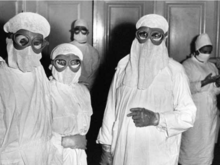1963 smallpox epidemic in Wrocław
- Machine translation, like DeepL or Google Translate, is a useful starting point for translations, but translators must revise errors as necessary and confirm that the translation is accurate, rather than simply copy-pasting machine-translated text into the English Wikipedia.
- Consider adding a topic to this template: there are already 1,470 articles in the main category, and specifying
|topic=will aid in categorization. - Do not translate text that appears unreliable or low-quality. If possible, verify the text with references provided in the foreign-language article.
- You must provide copyright attribution in the edit summary accompanying your translation by providing an interlanguage link to the source of your translation. A model attribution edit summary is
Content in this edit is translated from the existing Polish Wikipedia article at [[:pl:Epidemia ospy prawdziwej we Wrocławiu]]; see its history for attribution. - You may also add the template
{{Translated|pl|Epidemia ospy prawdziwej we Wrocławiu}}to the talk page. - For more guidance, see Wikipedia:Translation.
| 1963 smallpox epidemic in Wrocław | |
|---|---|
 Protective clothing worn by health workers during the epidemic | |
| Disease | Smallpox |
| Virus strain | Variola vera |
| Location | Polish People's Republic |
| Index case | A public officer returning from India (or another Asian country) |
| Dates | 17 July - 19 September 1963 |
| Confirmed cases | 99 |
Deaths | 7 |
An outbreak of smallpox occurred in the city of Wrocław in Poland in the summer of 1963. The disease was brought to Poland by an officer in the Ministry of Public Security who had returned from India. The epidemic lasted for two months, causing 99 people to fall ill and seven to die. It caused Wrocław to close and quarantine itself.[1][2]
It was one of the last smallpox outbreaks in Europe (the 1972 Yugoslav smallpox outbreak was last)[3] and the biggest disease outbreak in Europe until the COVID-19 pandemic.[4]
Poland started vaccination against smallpox in 1919 and eradicated it in 1937.[5]
Patient zero
The officer who brought the virus was a lieutenant colonel, Bonifacy Jedynak. He had returned from Delhi, India on 22 May 1963 and became infected by an unknown disease. He went to the hospital of the interior ministry in Wrocław where he was diagnosed with malaria. Meanwhile smallpox was transmitted to nurse who had mild symptoms and was considered to get chickenpox.[6][4] Her son, daughter and the attending doctor were infected and died later.[4]
Progress of epidemic

Lonia Kowalczyk was the first person who died because of the infection.[7] On 15 July 1963, an anti-epidemic emergency was announced in the city, 47 days after the first case of the disease. 10,000 vaccines were delivered from the Polish capital Warsaw that day. Around 1 million of vaccines was delivered from Soviet Union and from Hungary. Vaccination was mandatory from 1 August 1963. Non-stop vaccination centre was at Wrocław train station. Vaccination campaign took 2 months.
Initial estimate of WHO was that epidemic will last for two years with 2,000 deaths. Thanks to fast response and availability of vaccination, epidemic was suppressed and it was officially ended on 19 September 1963. 8.5 million of people were vaccinated in total.[4]
References
- ^ "Epidemic in Wrocław in 1963". Institute of National Remembrance. 18 March 2020.
- ^ "SMALLPOX BATTLE WIDENED IN POLAND". The New York Times. 27 July 1963. ProQuest 116618718.
- ^ Żuk, Piotr; Żuk, Paweł (24 September 2019). "One of the recent attacks of smallpox in Europe: A massive vaccination campaign during the epidemic in Wrocław in 1963". Vaccine. 37 (41): 6125–6131. doi:10.1016/j.vaccine.2019.08.038. PMID 31455585. S2CID 201654865.
- ^ a b c d "Jak socialistické Polsko zvítězilo nad epidemií pravých neštovic". A2larm (in Czech). 2021-01-30. Retrieved 2024-01-12.
- ^ Majmurek, Jakub (2021-01-26). "Obowiązkowe szczepienia i cała władza w ręce lekarzy. Jak PRL uporał się z epidemią". KrytykaPolityczna.pl (in Polish). Retrieved 2024-01-12.
- ^ Jasińska, Joanna (5 April 2020). "Lockdown and isolation: the summer a Polish city defeated an outbreak of one of the world's deadliest diseases". The First News.
- ^ Rosalak, Maciej (21 October 2020). "Wrocław w szponach zarazy. Miasto zostało odcięte od reszty kraju" [Wrocław in the grip of a plague. The city was cut off from the rest of the country]. Historia Do Rzeczy (in Polish).
- v
- t
- e
- First plague pandemic (541–767)
- Second plague pandemic (1348–19th century)
- Influenza pandemic (1510)
- Influenza pandemic (1557–1559)
- First cholera pandemic (1816–1826)
- Second cholera pandemic (1829–1851)
- Third cholera pandemic (1852–1860)
- Third plague pandemic (1855–1860)
- Fourth cholera pandemic (1863–1879)
- Fifth cholera pandemic (1881–1896)
- Russian flu (1889–1890)
- Sixth cholera pandemic (1899–1923)
- Spanish flu (1918–1920)
- encephalitis lethargica epidemic (1919–1930)
- Asian flu (1957–1958)
- Seventh cholera pandemic (1961–1975)
- Hong Kong flu (1968–1970)
- Russian flu pandemic (1977–1979)
- HIV/AIDS (1981–present)
- Swine flu (2009–2010)
- COVID-19 (2019–2023)
- Mpox (2022–2023)









